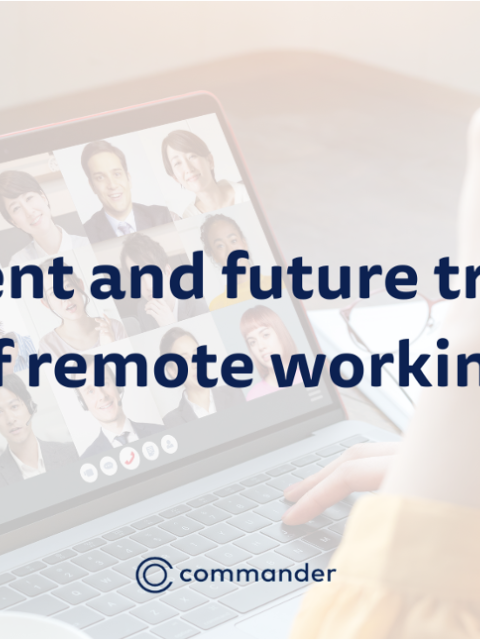
In recent years, we have seen monumental changes around remote working, with remote working now becoming the norm. The COVID-19 pandemic gave employees across the globe more flexibility to work on their terms, which created a ripple effect, leaving many businesses wondering, "what's next?".

Spending five days a week in the office may once have been seen as 'normal', but this certainly isn't the case in 2023. Flexible hours, shorter weeks, and hybrid/remote working – be that at home, from a café or even abroad – are all becoming the new normal.
The changes we have seen in such a short time highlight that most employers now offer more flexible working environments, which is tipped to continue in the future. Workplaces where we all have more freedom and control over what we do and where we do it. So, what are the current and future trends we expect to see for remote working in 2023?
Hybrid and remote working

Working from home (WFH) was a foreign concept ten years ago. It was a practice almost no workplace would accommodate unless it were for a special reason or an emergency. It was extremely rare and seen as impractical in the workplace.
The rise of the internet, paired with the global pandemic, dramatically changed this and prompted companies to re-evaluate how they operate.
In a survey conducted exclusively among HR professionals in July 2022, over 86% of respondents indicated that their organisation offered hybrid working on a flexible basis. Whereas only around 5% of the respondents said, their organisation did not offer flexible working arrangements. Whilst this is not reflective of occupations across the board, it is arguably a great indicator of the more general, office-based roles. It gives significant insight into the volume of employers implementing this 'perk'.
A separate survey, also conducted by Statista Research Department, revealed that in September 2022 (post-pandemic), Australians in New South Wales spent on average 2.53 days working from home, making this the most popular state for remote work.
This has had an overall positive result so far, with recent research showing that 87% of survey respondents from Flex Jobs stated that remote work options improved their overall work-life balance.
Now, in an (almost) post-pandemic world, many want to maintain this sense of freedom. Whilst most workplaces have re-introduced working from the office, many offer a hybrid working agreement, meaning there is a combination of working from home and in the office.
Further employee benefits
With a high demand for workers across Australia, one of the main difficulties amongst businesses is finding and retaining staff. This inevitably puts the power back into the hands of the employee, creating more competition amongst employers as they fight to lure in staff with more attractive employee benefits.
In November 2022, the most searched term on SEEK was 'working from home', a clear indication that people are looking to maintain this flexibility. In 2023 people, more than ever, people are questioning what THEY want from an employer, and remote working is evidently part of this.
Digital Nomads

We are also seeing a rise in fully remote jobs. In these instances, communication and work are maintained entirely via online emails, video calls and messaging apps such as Slack.
As a result, more people are abandoning their traditional 9-5 life for the life of a digital nomad. This is someone known to travel whilst working online, often in exotic locations overseas, using cafes and co-working spaces to connect to WIFI. Places such as Canggu in Bali, Lisbon in Portugal, Chiang Mai in Thailand and Mexico City are all hotspots for this and have excellent infrastructure to cater for these workers.
An MBO Partners study revealed that in the US, there was a rise of 131% in people describing themselves as a DN from 2019 to 2022. America was also said to be the most popular home country for DNs. The number of digital nomads with traditional jobs increased by 9% in 2022, growing from 10.2 million in 2021 to 11.1 million in 2022. This is on top of the number of digital nomads, with traditional jobs doubling in 2020 and increasing by 42% in 2021.
What can we expect to see next?
It is fair to say that the prospect of remote work has been well received, particularly from the employee's perspective. As employees gain more control over their work life, it's expected that this will continue to become something they demand and expect from an employer.
As we continue to adopt a more flexible approach in 2023, here are some key areas and trends we can expect to develop within remote working.
Increased cybersecurity protection
According to a Global Cisco survey, 85% of organisations said that cybersecurity is more important now than before the pandemic. Many businesses were not prepared for the abrupt transition from office to home. However, we can expect that more will be done to protect the commercially confidential data we hold on our work gadgets in future as remote work becomes more predominant.
Further flexibility and work perks
In this modern day, as many seek to maintain their work/life balance, we can expect to see the adoption of some additional perks. Some companies are giving their staff the option to have a 'remote work' pass which they can use to work from a location of their choice for up to 6 weeks a year.
Along with this, the implementation of a 4-day work week is being introduced within some companies across Australia. We expect to see a rise in workplaces trialling (and potentially adopting) this in upcoming years.
Does your business offer remote or hybrid work? Ensure you and your team stay connected with our business communication solutions, including business nbn® and Enterprise Ethernet.
View our range of business nbn® plans or our Enterprise Ethernet plans. Alternatively, you can call 13 70 90 to talk to one of our experts to help find the right solution for your business.